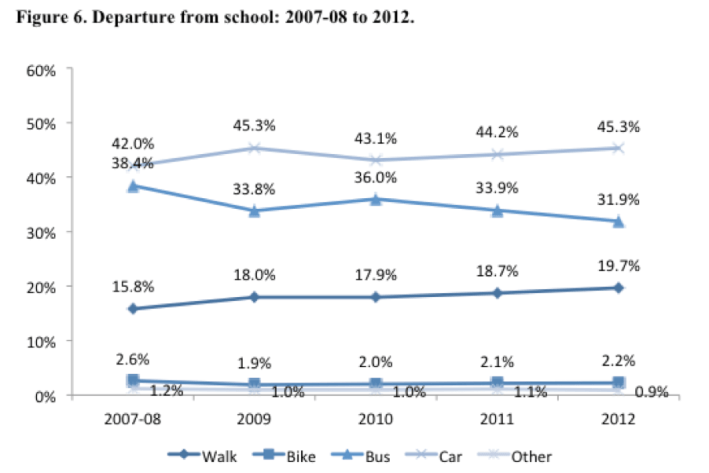
The long-term decline of walking and biking to school has been linked to the childhood obesity epidemic, a big share of morning rush hour traffic, and even kids' lack of attention in class. In 1969, 41 percent of children in grades K–8 lived within one mile of school, and of those kids, 89 percent usually walked or biked. By 2009, 31 percent lived within a mile of school -- and only 35 percent of them walked or biked.
It’s too soon to say that downward spiral is over. But there are hopeful signs.
A new report released by the National Center for Safe Routes to School shows that more kids are walking. However, biking seems to be staying flat, and busing is down.
First, a disclaimer: The study is based on somewhat uneven data. The 2005 national transportation bill, which created the federal Safe Routes to School program and started disbursing money to states, also mandated the implementation of a data collection system. Compliance has been rising dramatically -- 382 schools submitted information in 2007, while 8,119 did this year. So current data is more robust than past years, and you should take the year-over-year trend results with a grain of salt.
In addition, rural and low-income students are under-represented in the surveys, as are kids living far from school. In total, more than 525,000 parent surveys from 4,691 schools supplied information for the study.
That said, the National Center found that walking to and from school increased among respondents between 2007 and 2012. While 12.4 percent walked to school in the morning in 2007, 15.7 percent did in 2012. In the afternoon, 15.8 percent walked home in 2007, versus 19.7 percent last year.
The difference between morning and afternoon makes sense. People are in a bigger rush in the morning and might be tempted to drive. Working parents might be available to drive in the morning but not in the afternoon. Plus, it’s colder in the mornings.
Meanwhile, cycling to school dropped from 2.6 percent of school kids in 2007-08 to 1.9 percent in 2009, then ticked up slightly each year to 2.2 percent in 2012. Since the first years of data collection had the smallest sample size, it's hard to discern a meaningful shift.
Has SRTS been more successful installing good walking facilities than bike infrastructure? Are misguided school rules against biking holding back growth in cycling to school?
One thing is clear: Budget cuts have taken a big bite out of school busing. School bus ridership has dropped about 6 percent.
It's reassuring that the slack hasn’t been entirely picked up by driving. In 2012, 54.7 percent of kids got to school in a car in the morning and 45.3 percent in the afternoon. That’s more than in 2007-08, when it was 51.4 there and 42 percent back. But it only accounts for about half the decline in busing. Walking takes up the other half.
Surveys asked parents whether their kids had asked permission to walk or bike, and whether they (the parents) thought walking and biking to school was fun and healthy. The survey also asked whether the school actively encouraged walking and biking.
Parents who answered yes to those questions were far more likely to have kids who walked and biked, though it’s tough to gauge the cause and effect. Maybe parents whose kids have to walk or bike because there's no other good option make themselves feel better by getting excited about the health benefits and convince themselves their kids like it. And weirdly, slightly fewer parents think walking and biking is healthy and fun now than in 2007-08.
But school encouragement -- or at least parents’ perceptions of it -- has grown markedly, from 24.9 to 33 percent. That’s still hideously low -- but the growth is pretty good evidence that Safe Routes to School and, possibly, First Lady Michelle Obama’s Let’s Move campaign are having a major impact. But school support seems to be more important when it comes to walking than biking. The kids who biked were largely those whose parents said they enjoyed it.
Boys and girls were about equally likely to walk, but boys were twice as likely to bike. The most likely students to walk were older kids “attending low-income schools in cities who asked permission to walk or bicycle.” Upper-income kids were more likely to get to and from school in a car -- or on a bike -- than their lower-income counterparts.
Kids who lived closer to school were more likely to walk than those who lived further away -- living more than half a mile from school meant a kid was only 16.3 percent as likely to walk as kids living closer [THAN A MILE?]. But kids living more than a mile away were 48 percent more likely to bike.
The data leaves a lot to be desired, but what it seems to show is that kids are out walking more, perhaps as a result of greater school encouragement or cuts to school bus service -- or both.
Will the country get back to 89 percent active transportation for kids who live near school? It's too soon to say, but the journey of a thousand schoolkids begins with one step.





